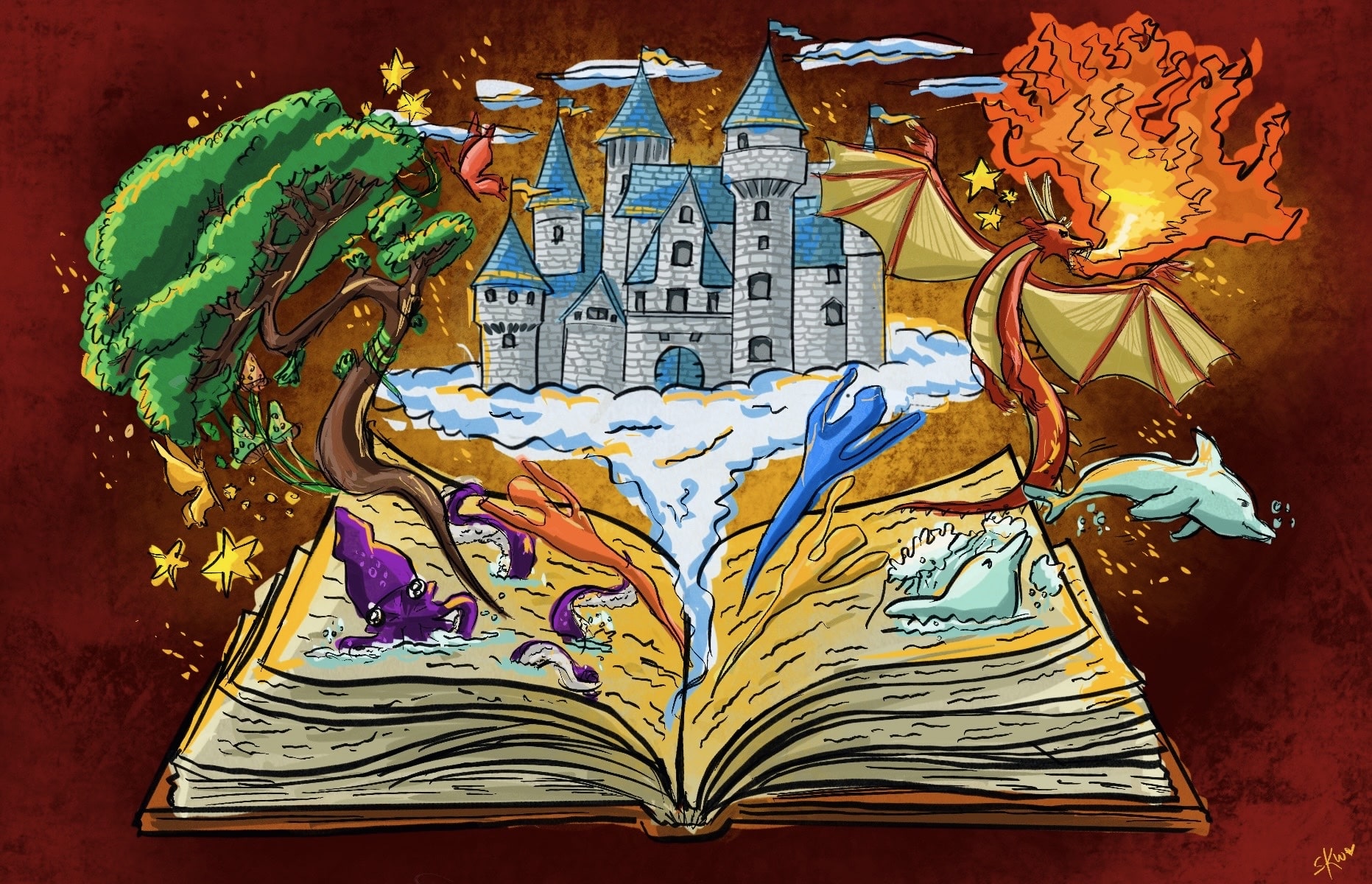Editorial: the spoken weapon
How storytelling breaks boundaries to reclaim identities, convey harsh realities, and pass on traditions.
Set in locations ranging from Toronto to Haiti to Timmins to Saint Lucia, acclaimed Canadian poet Canisia Lubrin’s debut work of fiction, Code Noir, adopts the novel approach of assorting 59 short stories, each differing in length, genre, character, and plot, but unified in their reflections on the brazenness of life. Strikingly, the novel’s title takes inspiration from the infamous, real-life Code Noir, a decree consisting of 59 articles established by King Louis XIV in 1685 outlining the operation of slavery in the French empire and its colonies.
Such a title juxtaposes Lubrin’s humanistic narratives, which dwell on the lived experiences of African and Caribbean ancestry, with a landmark document epitomizing a nation’s embrace of a brutal institution. Such a choice goes beyond irony; it involves the claiming of a history that robbed millions of their lives and liberty through a methodical interaction with the haunting past, overlaying on its contours the stories of those who lay claim to a tragic heritage.
Code Noir’s storytelling is a testament to capturing tough subjects and reclaiming identities. Whether it’s through helping readers digest complex information or conveying an obscure but meaningful message, storytelling is a medium without restriction that can be used across the dimensions of the ideology, religion, politics, and literature, reflecting the power of imagination in working with the worst of realities.
The timeless universality of storytelling: Wagamese’s Indian Horse
Take Richard Wagamese’s 2012 novel, Indian Horse, which follows the story of Saul, an Ojibway boy taken to St. Jerome’s residential school in Ontario, where he blossoms into a hockey star while facing incessant prejudice, trauma, and sexual abuse. In 2012, between Stephen Harper’s apology to former residential school students in 2008 and the publication of the Truth and Reconciliation Committee’s report in 2015, Canada was still awakening to the horrors of the residential school system.
To faithfully convey even a glimpse of these horrors was not an easy task, especially as they constituted what many would consider Canada’s darkest era. Wagamese responded to this literary dilemma by building a fictional narrative based on this stark history. Now in novel form, the narrative could better avoid triggering defensiveness or aversion from its readers and instead patiently develop its plot, helping the reader digest the cruel reality of residential schools.
Through storytelling, Wagamese effectively leverages timeless universality and the language of emotion to impress upon the reader the harsh realities of the Indigenous experience in Canada. In focusing on Saul, a young child thrown into unimaginable circumstances, the reader is subconsciously coerced into feeling compassion, making them hyper-aware of the injustices he experiences through a human-centered lens.
The book also casts Saul as an underdog, whose passion for hockey is limited by his age and undermined by racial prejudice. This enables the reader to greatly identify with Saul, putting them in his shoes and motivating them to take pleasure in his success and mourn his losses.
Here, the story plays on the universal inclination to pity the character who unjustly faces prejudice and is powerless to combat it, an emotion as timeless and human as the fight against oppression itself. Encapsulating such an emotional trigger allows anyone, of any age or era, to share in the emotions of the sufferer. In inspiring this response through Indian Horse, Wagamese successfully conveys the novel’s big idea of the ferocity of residential schools.
Storytelling also relies on the timeless universality of language. Language is most relevant to the human species, in whose history it “would stand out as the preeminent trait,” according to cognitive psychologist Steven Pinker in his book, The Language Instinct: How the Mind Creates Language. Pinker further claims that language is “man’s most important cultural invention” and is “so tightly woven into human experience that it is scarcely possible to imagine life without it.”
The power of language can also be examined by extrapolating it beyond the human world and into the hands of an extraterrestrial species. This idea is central to the 2016 sci-fi film Arrival, based on Ted Chiang’s Story of Your Life, in which the language of the narrative’s aliens is interpreted as a “weapon,” which, if learned, would alter the human learner’s linear perception of time and enable them to become aware of future experiences. Regardless of what species uses it, language indeed is a weapon, especially among humans, whose perceptions of space and time are affected by the languages they speak.
While Wagamese’s choice to write a book might seem trivial, at its core, such a decision relies on a universal tool that epitomizes boundlessness. Every word, punctuation, and literary device used in the novel, along with the information it conveys, delineates the authority of language, not only as a form of communication but as a facet of life itself.
Storytelling as a survival mechanism
Indian Horse is presented as a story inside a story, with the internal narrative written by Saul as a part of his journey toward emotional healing during his time at an Indigenous rehabilitation centre. In this sense, storytelling became a part of his survival, a way to confront the trauma that poisoned him for years.
Key to this process is Saul’s reclaiming of the lost parts of his identity, which he accomplishes after seeing his dead family during a spiritual experience that prompts him to revisit the locations, both physical and psychological, of his abuse. As a result of his storytelling and resultant catharsis, Saul returns to his ancestral land at God’s Lake in Manitoba, where he, in a vision, talks to his great-grandfather, the first “Indian Horse,” fully reclaiming his heritage.
Saul’s journey reflects the role storytelling has played in Indigenous communities for centuries, as families passed on values, beliefs and traditions through oral tradition, the chief means of ensuring the survival of their culture and tradition. This history was disrupted, however, as Indigenous identities were devastated by colonialism and cultural genocide. During this time, Indigenous peoples experienced a significant loss of language, culture, and traditional teachings while enduring traumas inherited by subsequent generations. Such deprivation suffocated parts of Indigenous culture, as cultural storytelling, the lifeblood of tradition, was destroyed.
Today, just as Saul found a way back to his roots through the telling of his story, storytelling has risen as a means of reclaiming lost Indigenous identities and returning agency to the systemically silenced. This is seen through writers like Wagamese, who, after reuniting with his family, was given the name Mushkotay Beezheekee Anakwat, or Buffalo Cloud. Those given this name by elders in the community are responsible for telling stories and bearing a centuries-old Indigenous tradition.
At the intersection of Code Noir and Indian Horse lies the use of storytelling to convey an idea against the backdrop of a brutal history. In Code Noir, such history is captured in one of the 59 tenets which is presented before each short story. In Indian Horse, that history is the story itself. Both texts rely on the power afforded by storytelling: the ability to wield the weapon of language and reflect on reality through emotional stories, whether to influence public discourse, start a conversation, or inspire the finding of a lost identity.
News Editor (Volume 51); Associate News Editor (Volume 50) — Samuel is a second-year student at UTM studying Politics and English. He previously worked with The Medium as an Associate News Editor and currently serves as the publication’s News Editor. Samuel is passionate about employing the power of writing to enhance our student community and hopes to help nurture a bright future for The Medium this year. In his spare time, Samuel can be found working out, creating music on the piano and drums, or exploring nature.


